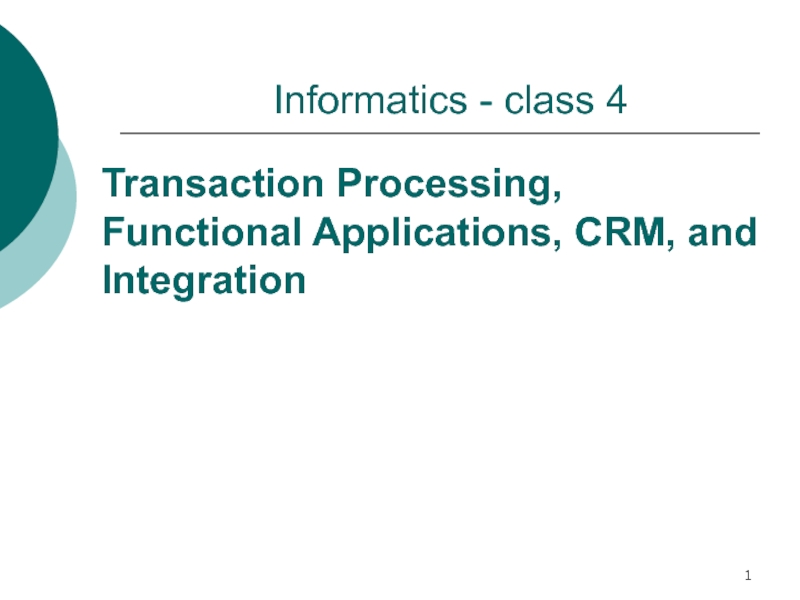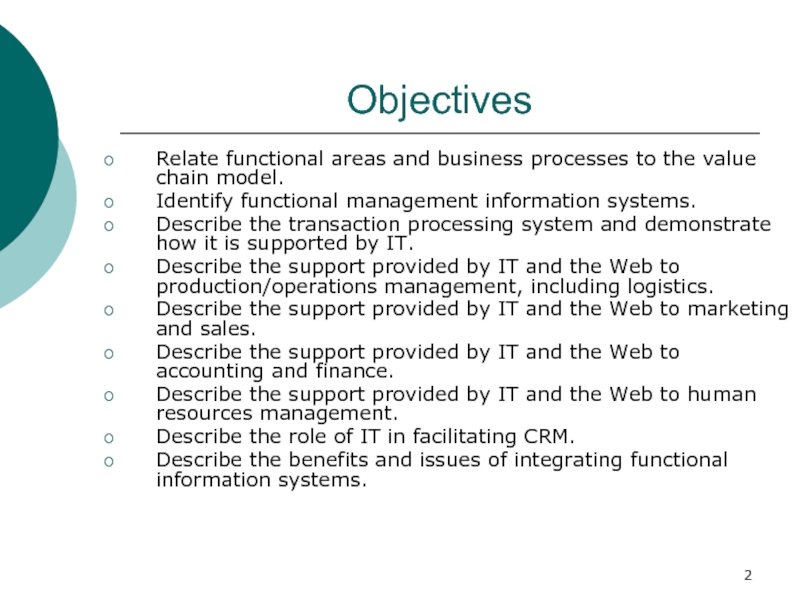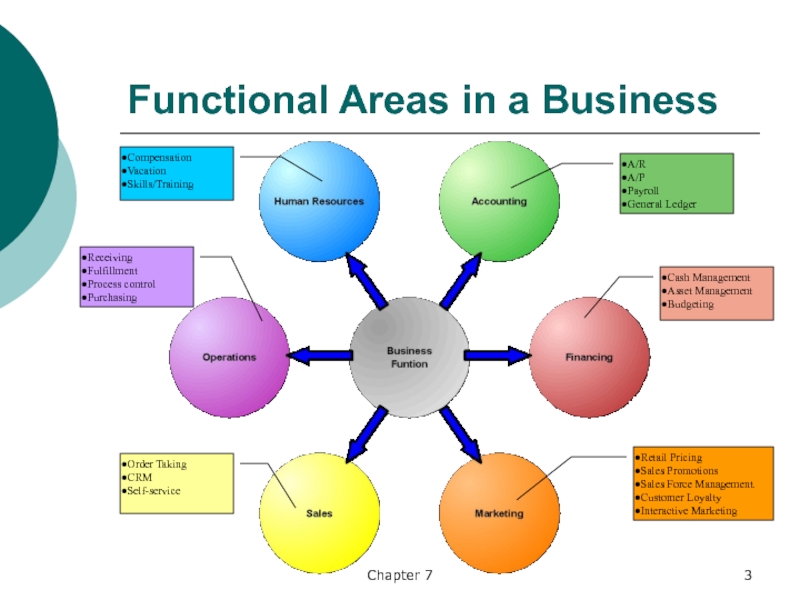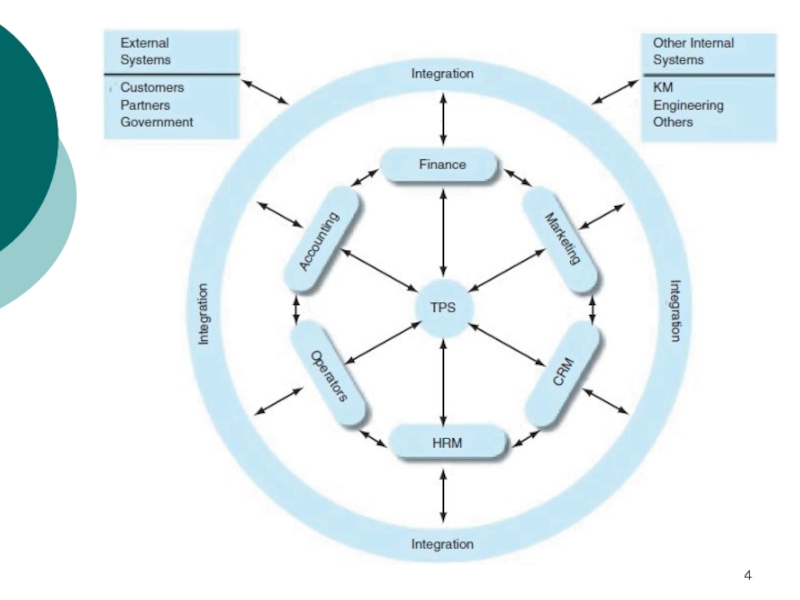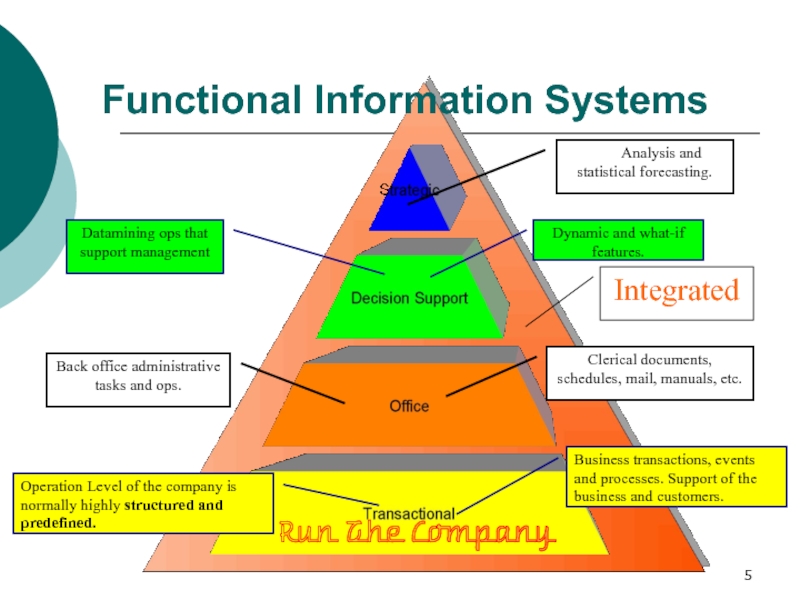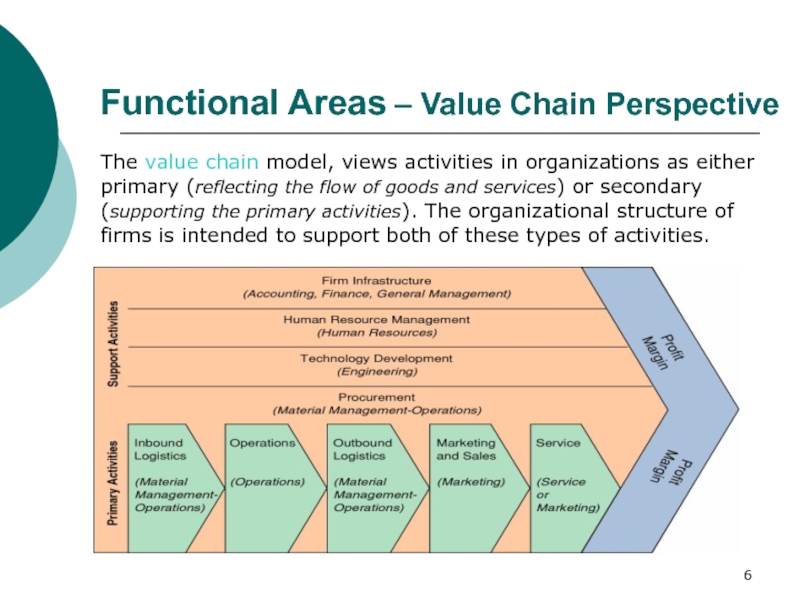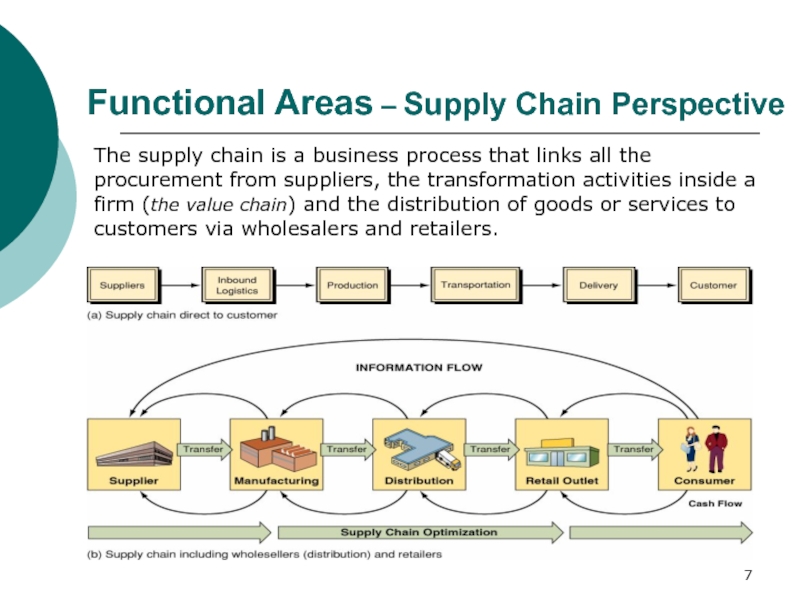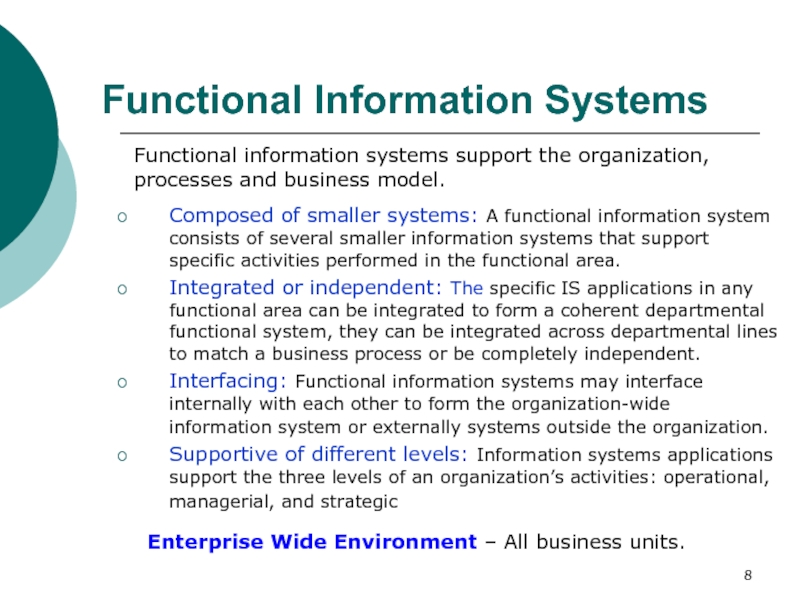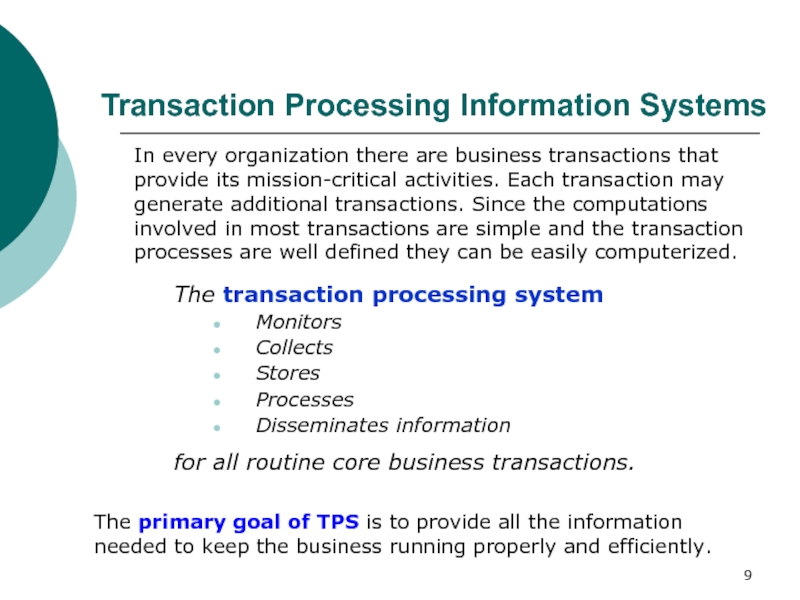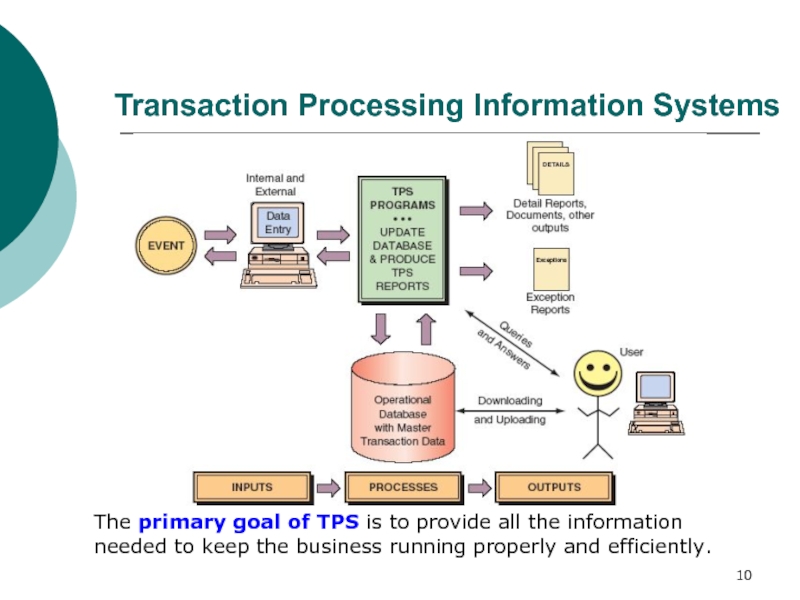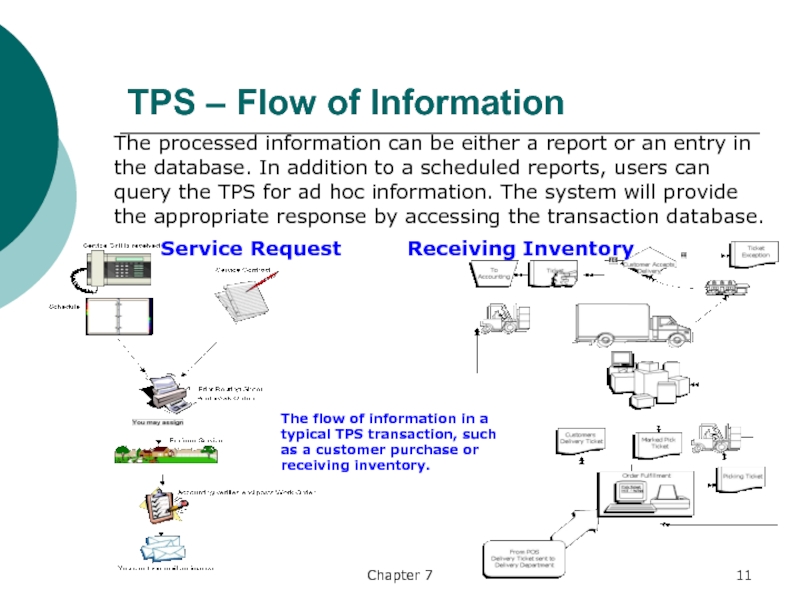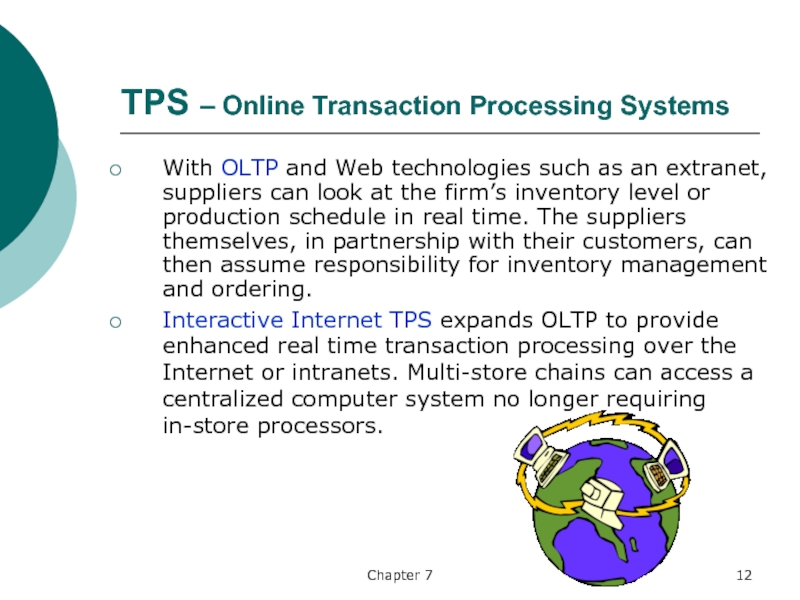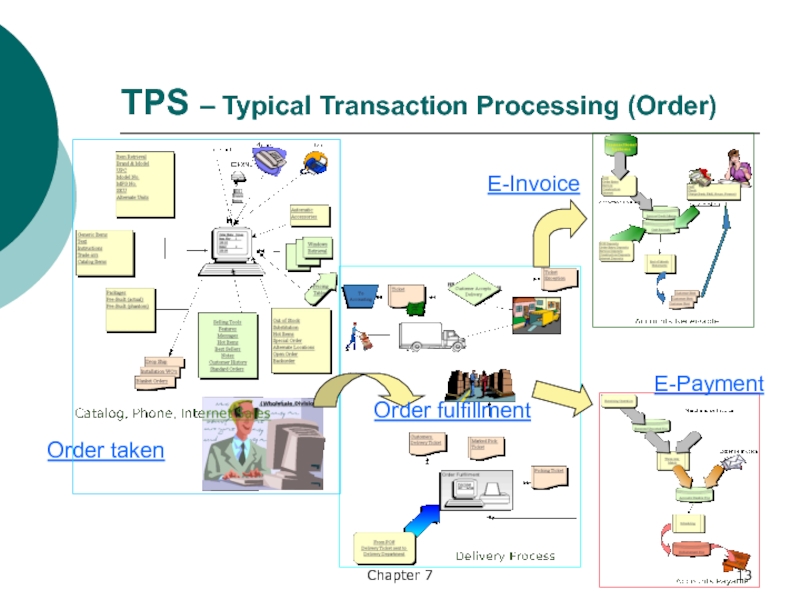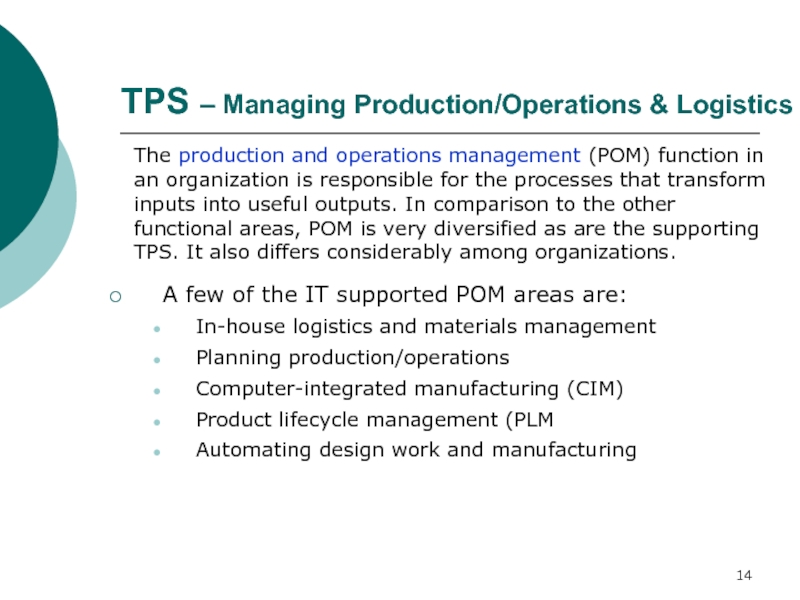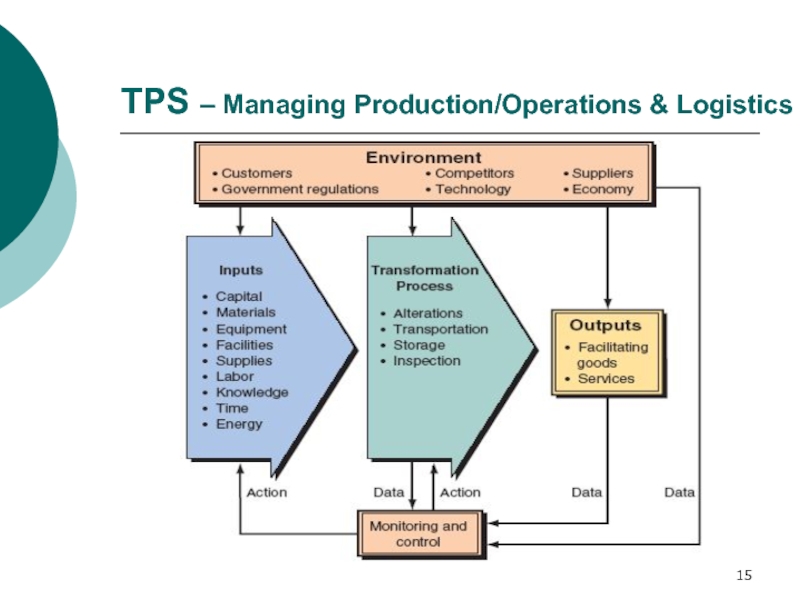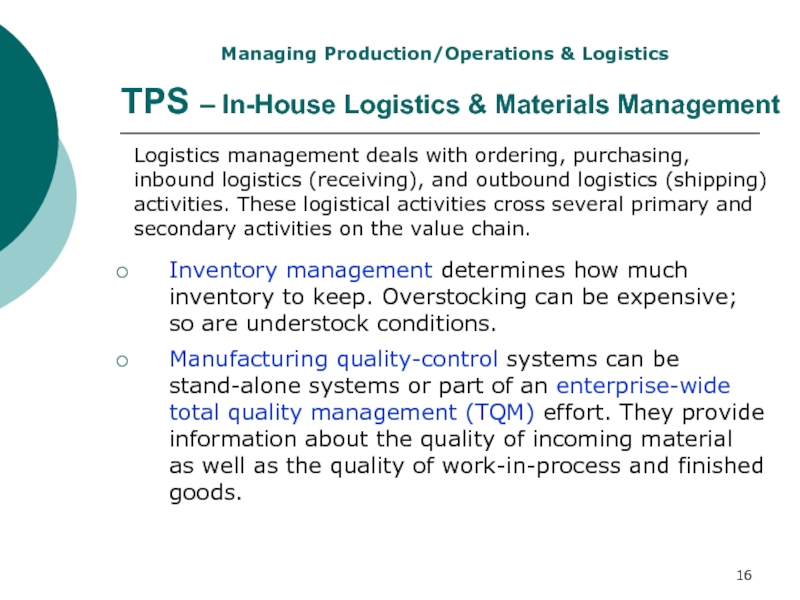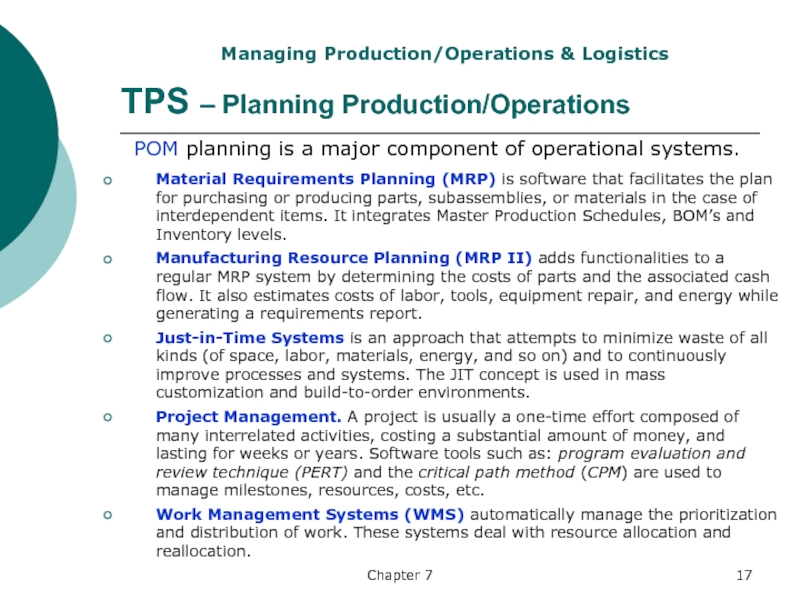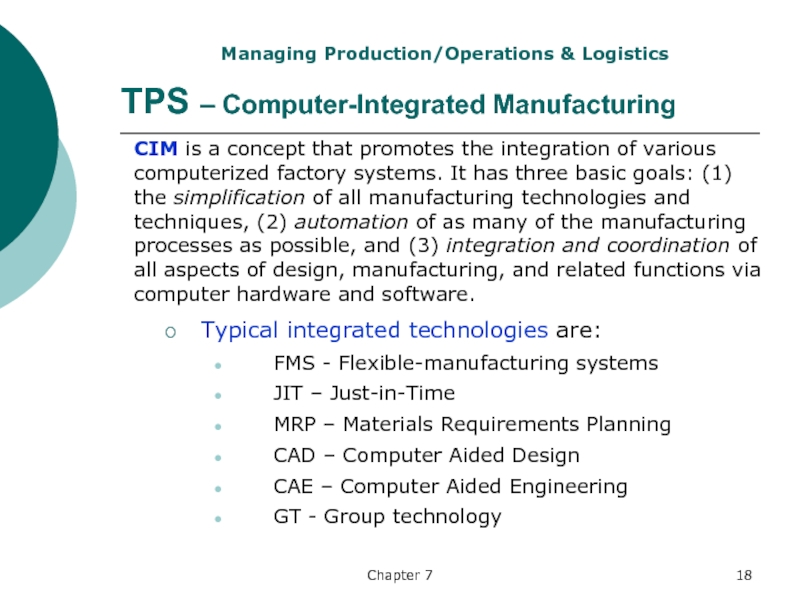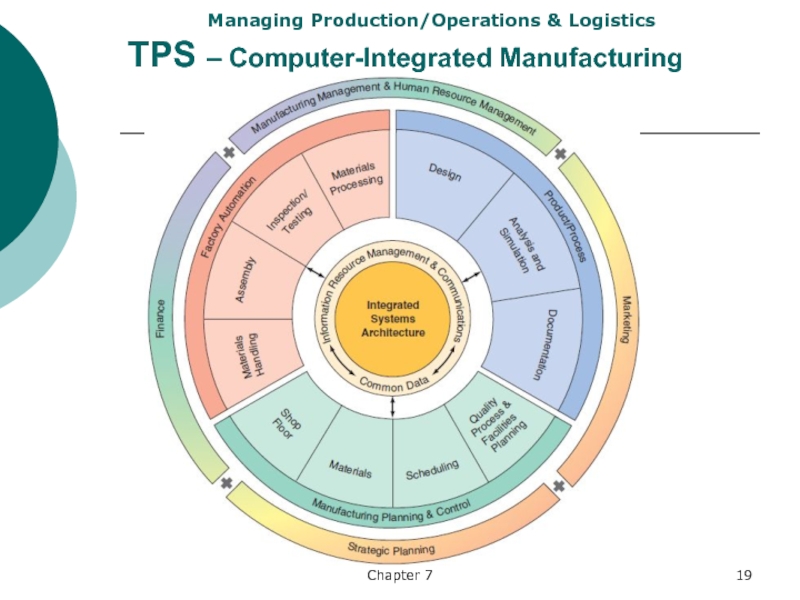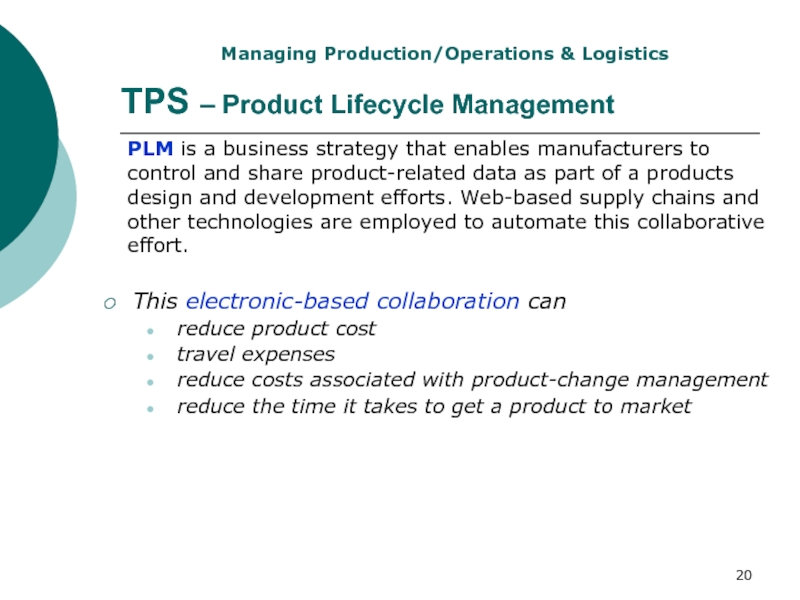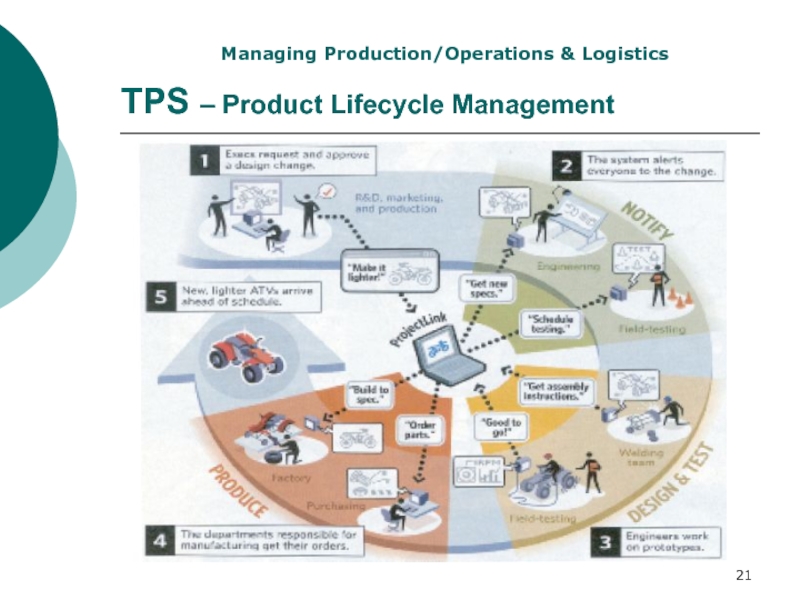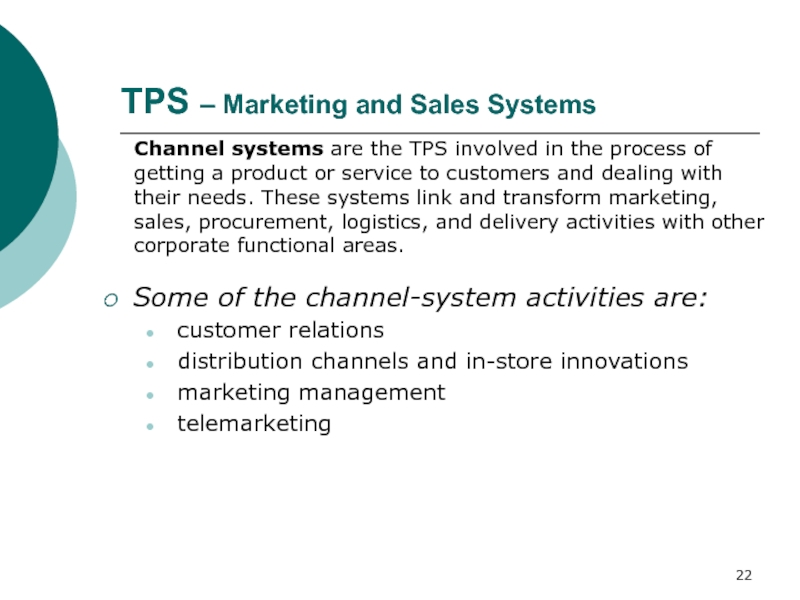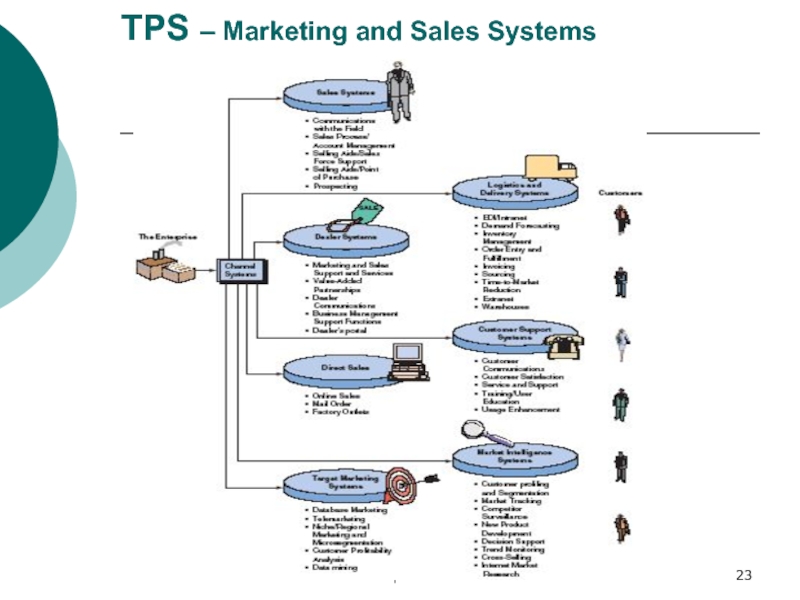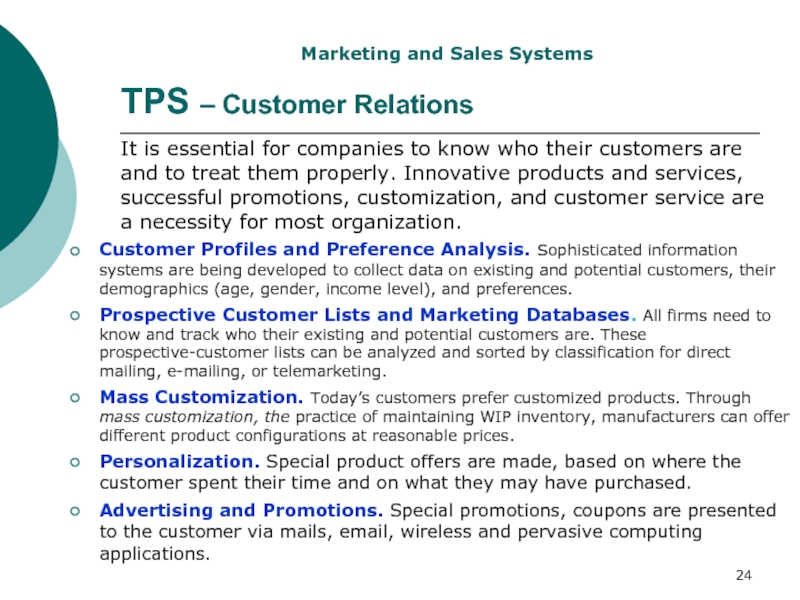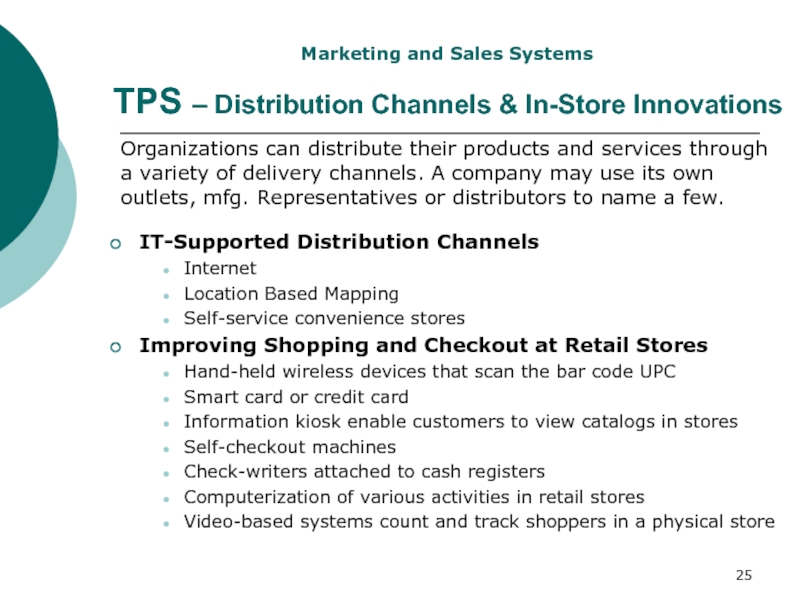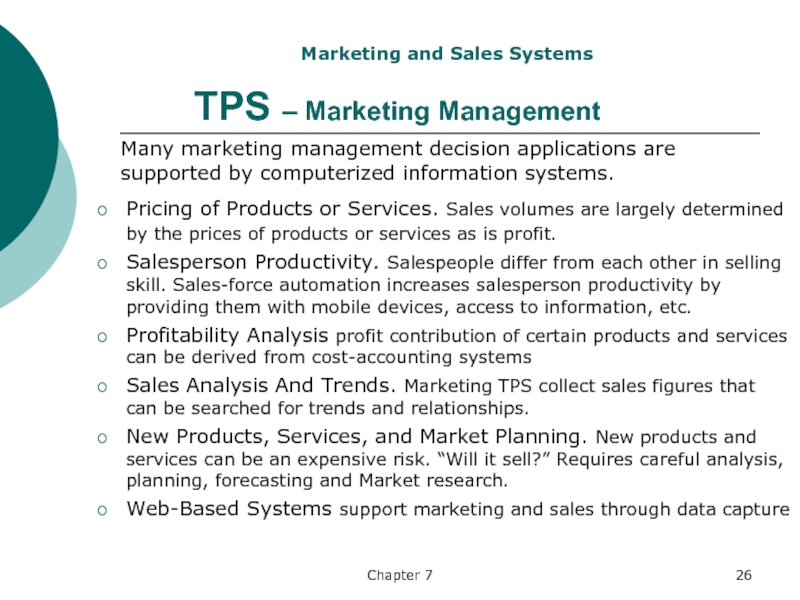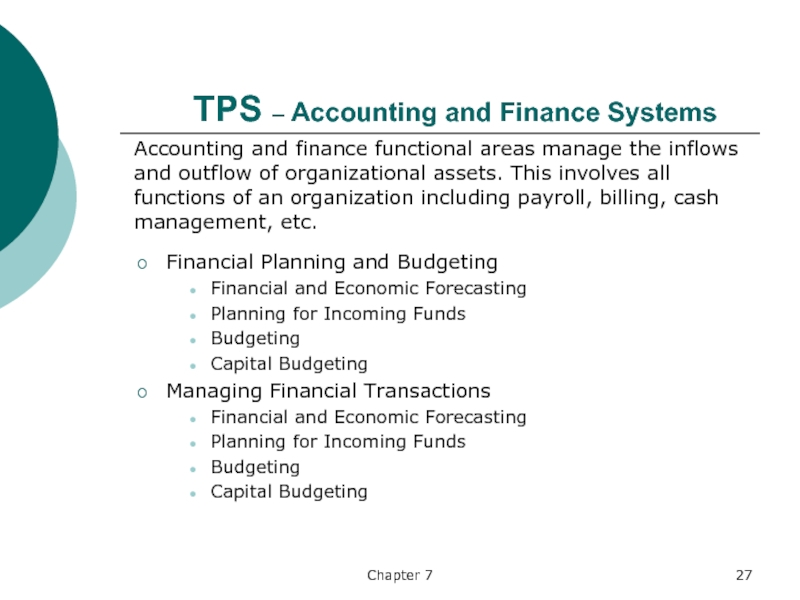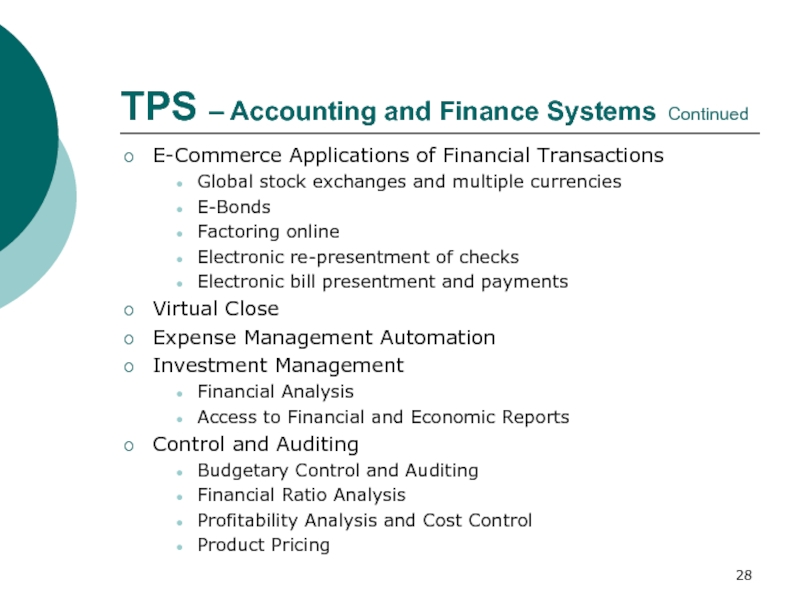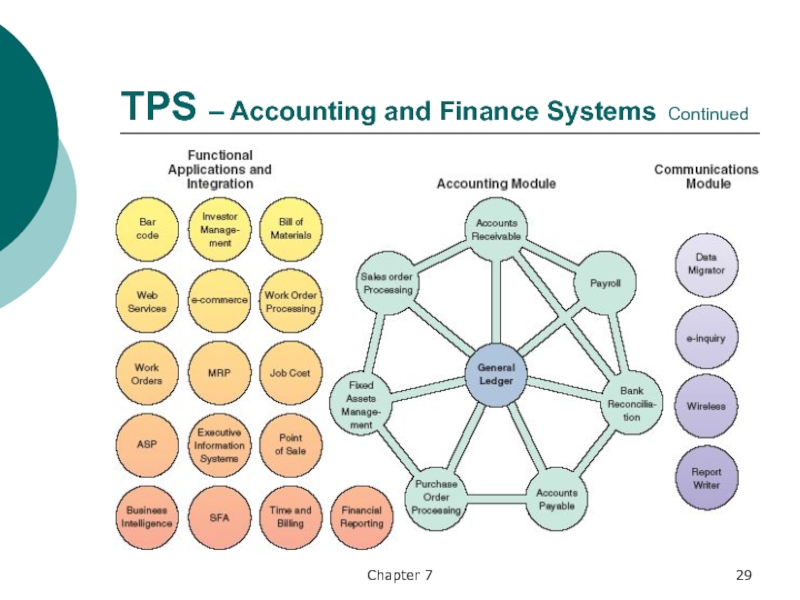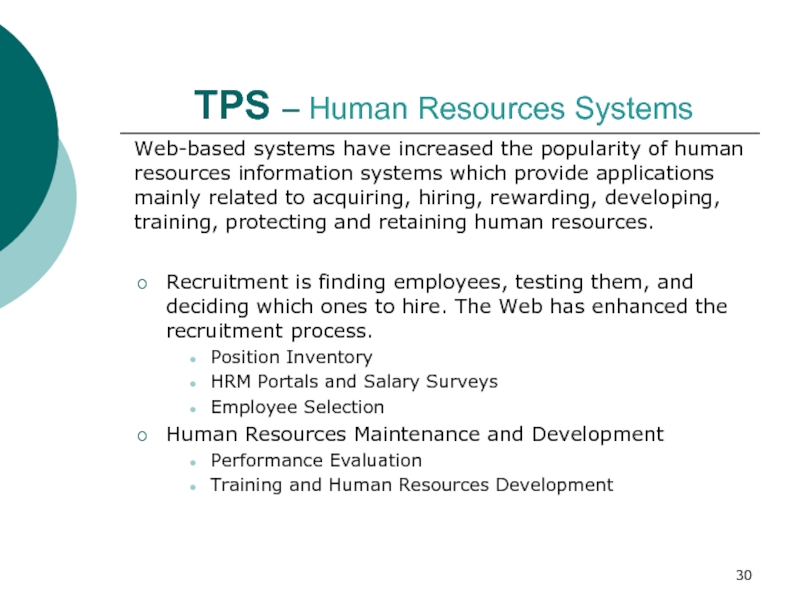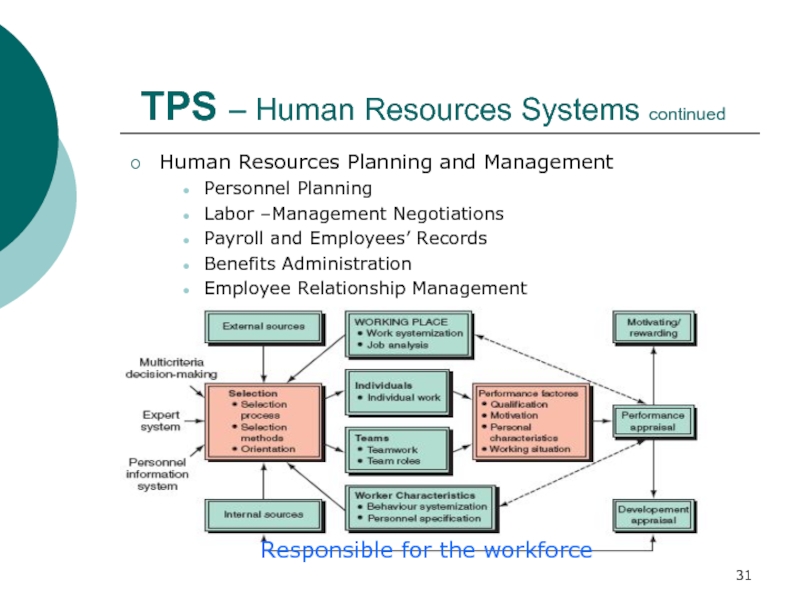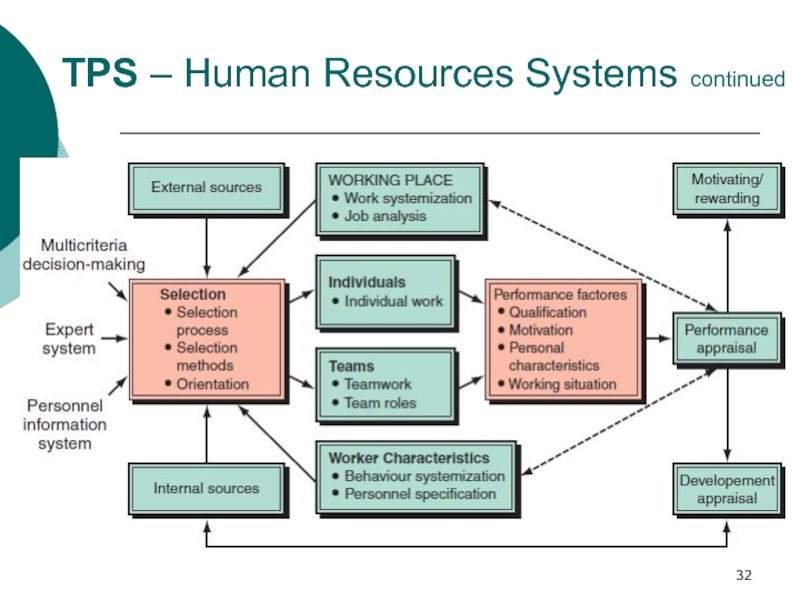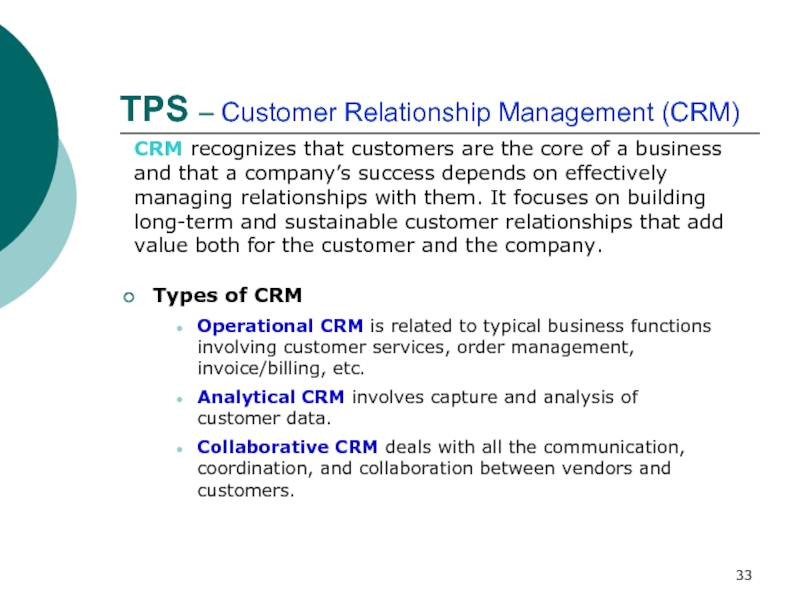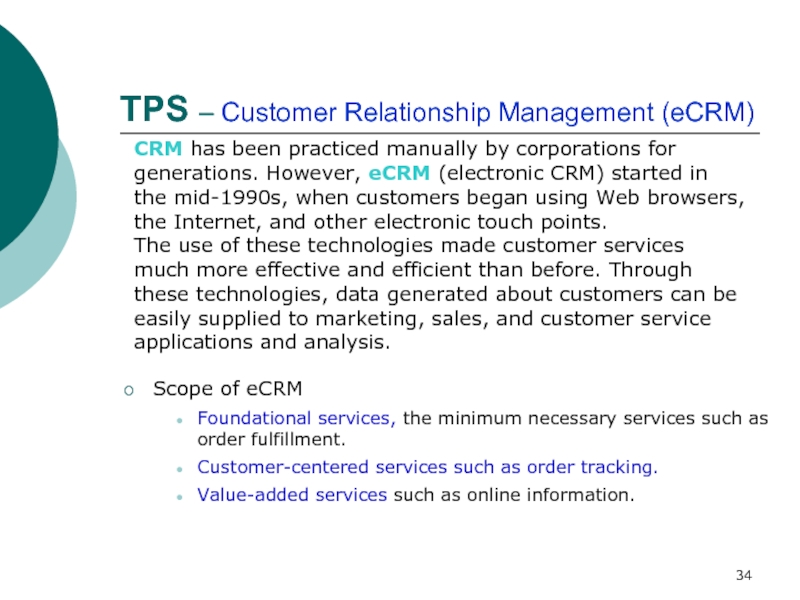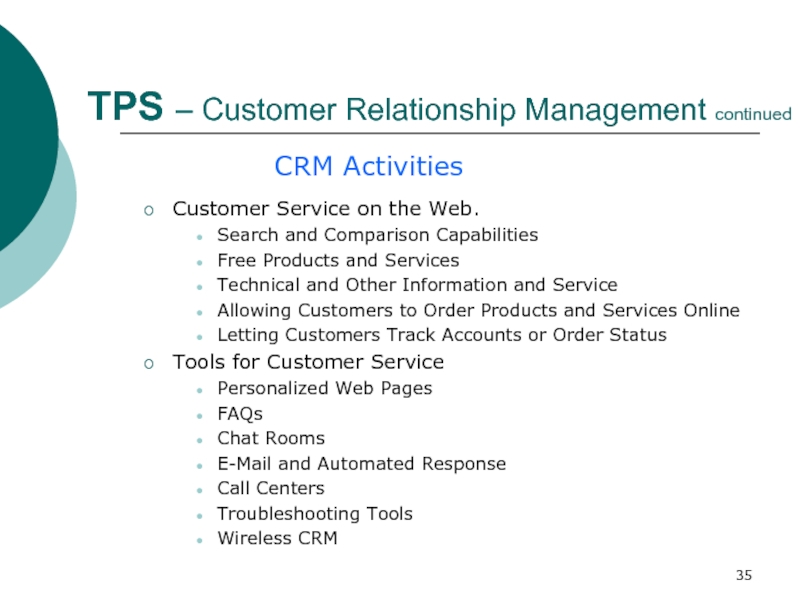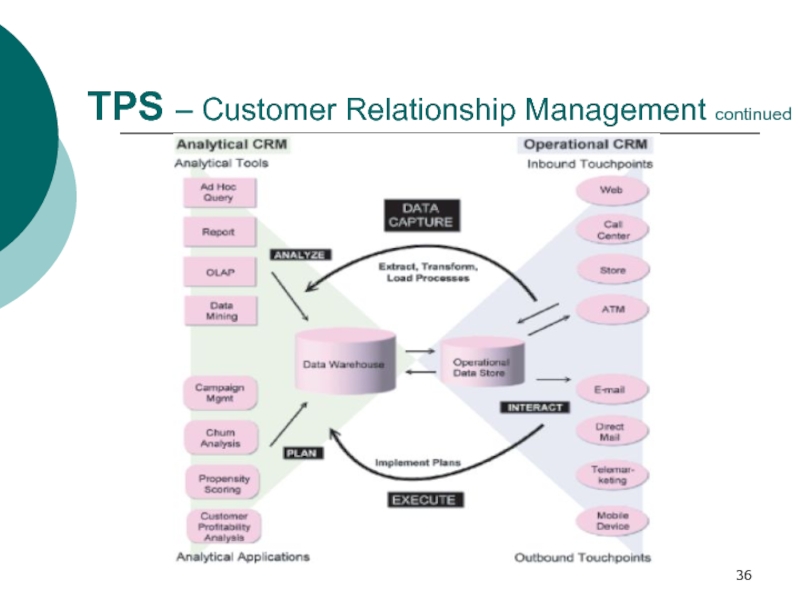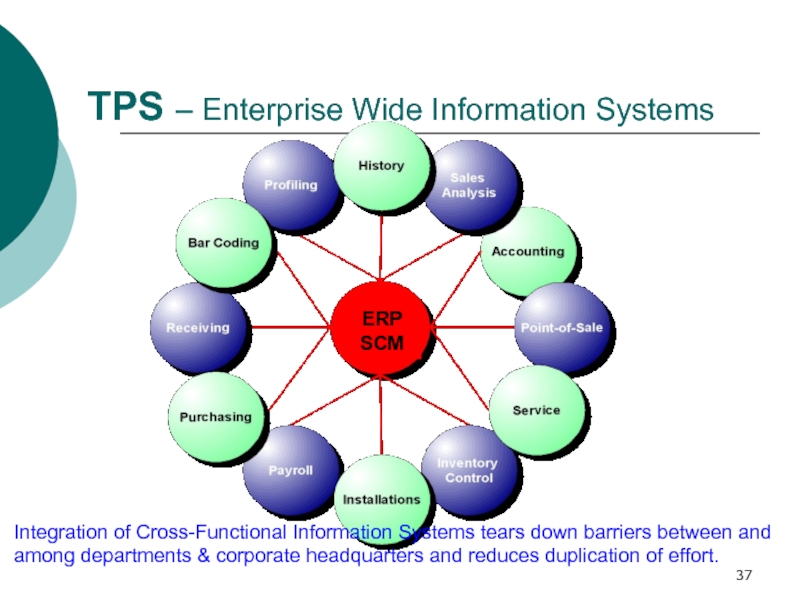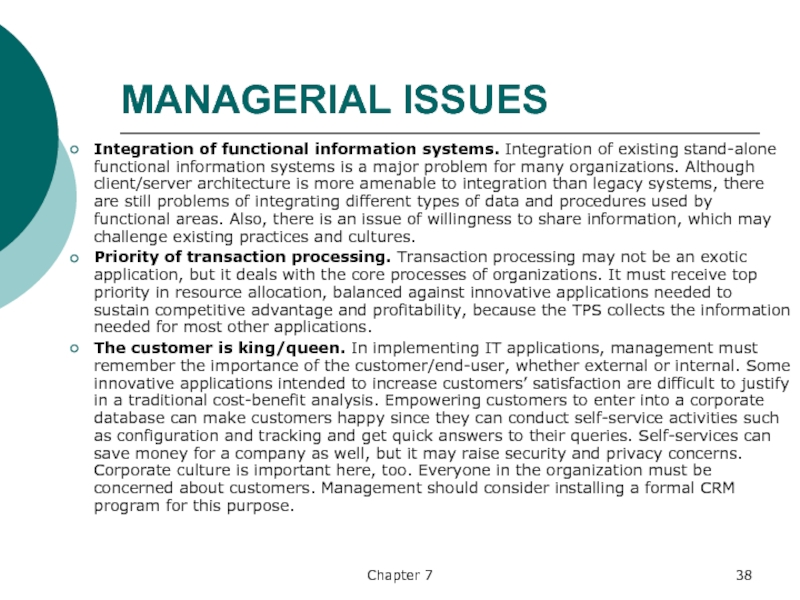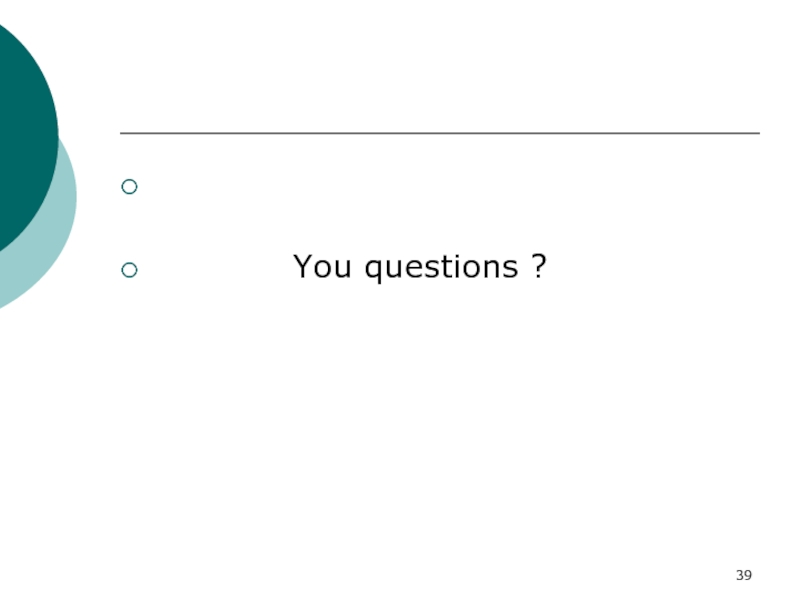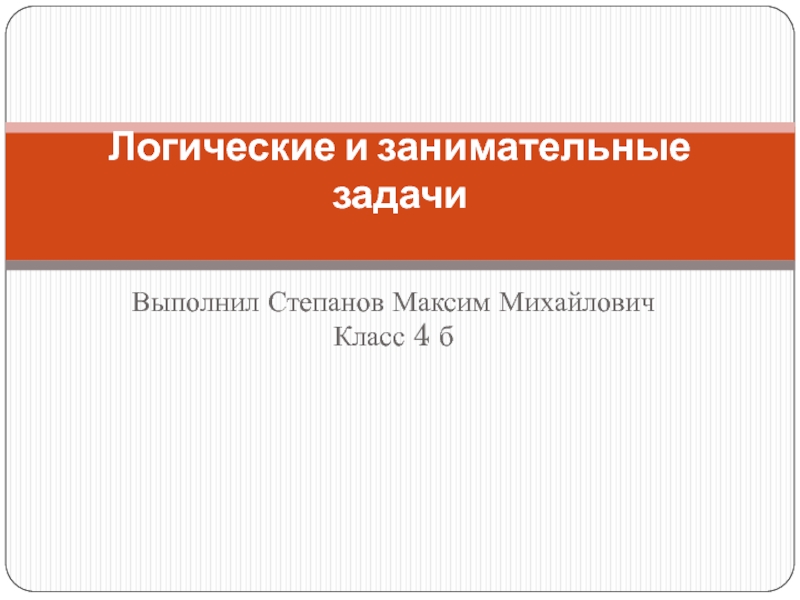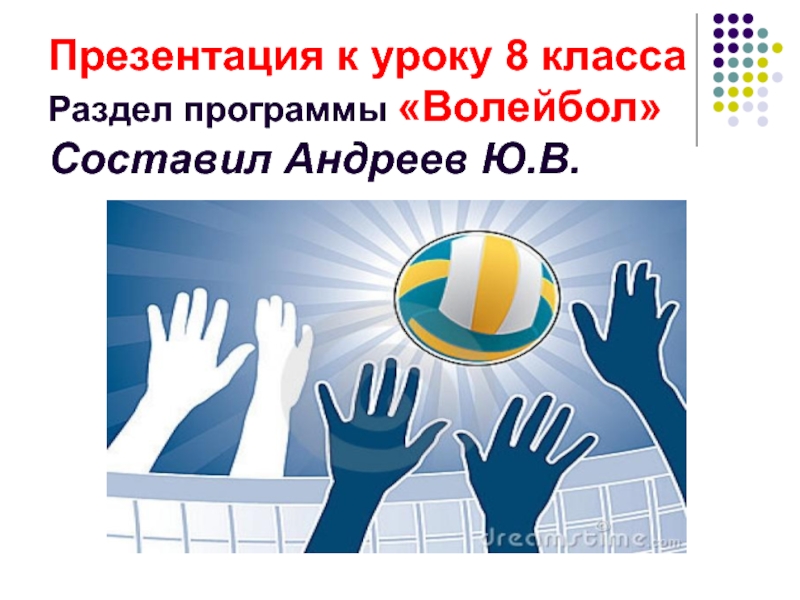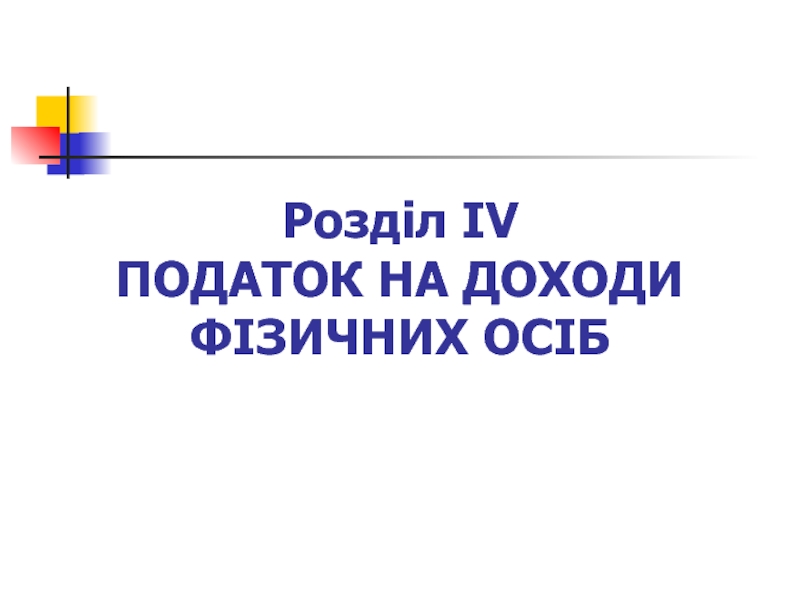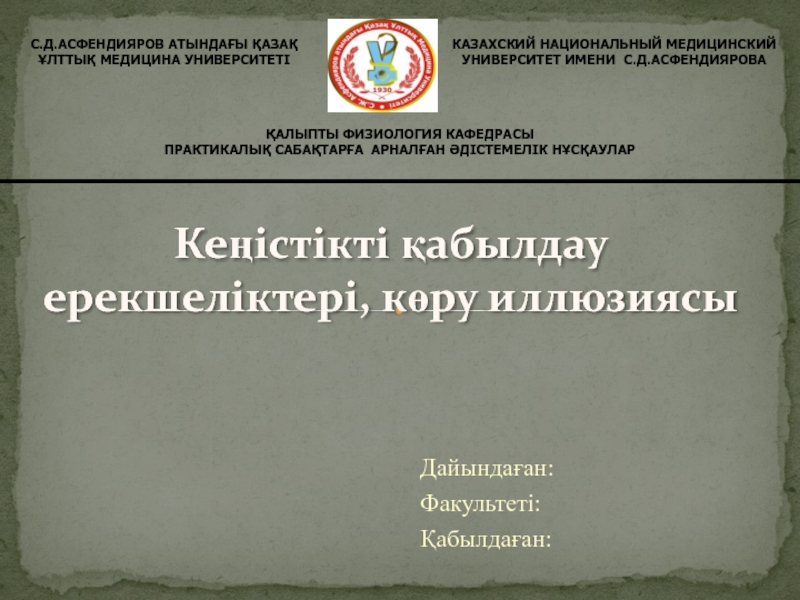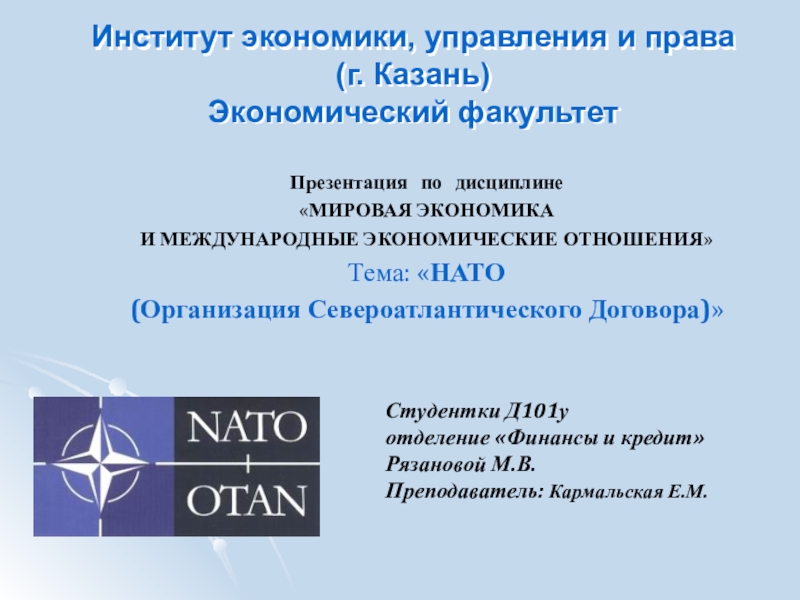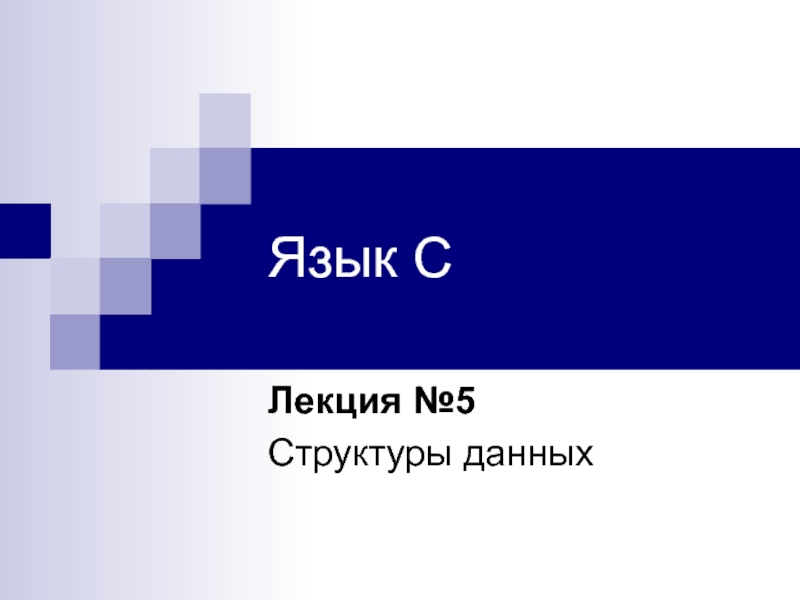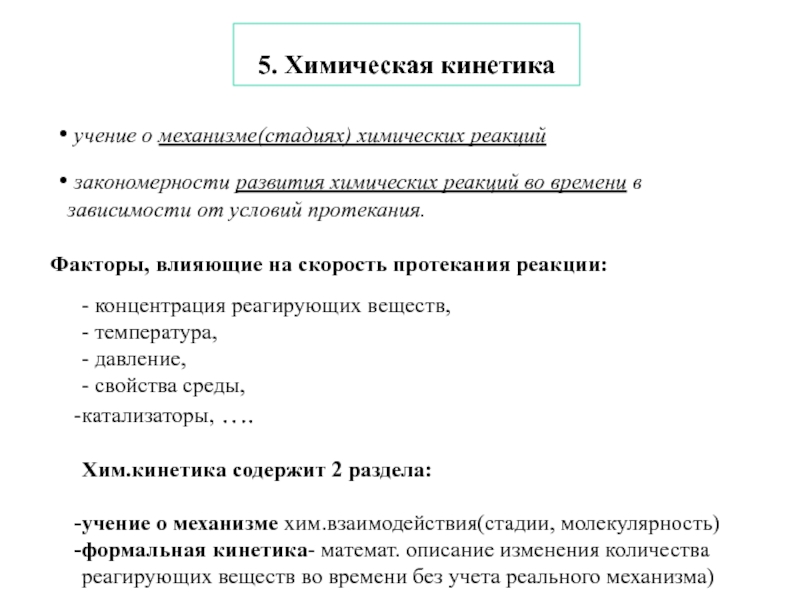Разделы презентаций
- Разное
- Английский язык
- Астрономия
- Алгебра
- Биология
- География
- Геометрия
- Детские презентации
- Информатика
- История
- Литература
- Математика
- Медицина
- Менеджмент
- Музыка
- МХК
- Немецкий язык
- ОБЖ
- Обществознание
- Окружающий мир
- Педагогика
- Русский язык
- Технология
- Физика
- Философия
- Химия
- Шаблоны, картинки для презентаций
- Экология
- Экономика
- Юриспруденция
Informatics - class 4
Содержание
- 1. Informatics - class 4
- 2. ObjectivesRelate functional areas and business processes to
- 3. Chapter 7Functional Areas in a BusinessCash ManagementAsset
- 4. Слайд 4
- 5. Functional Information SystemsBusiness transactions, events and processes.
- 6. Functional Areas – Value Chain PerspectiveThe value
- 7. Functional Areas – Supply Chain PerspectiveThe supply
- 8. Functional Information SystemsComposed of smaller systems: A
- 9. Transaction Processing Information SystemsThe transaction processing systemMonitorsCollectsStoresProcessesDisseminates
- 10. Transaction Processing Information SystemsThe primary goal of
- 11. Chapter 7TPS – Flow of InformationThe processed
- 12. Chapter 7TPS – Online Transaction Processing SystemsWith
- 13. Chapter 7TPS – Typical Transaction Processing (Order)Order takenOrder fulfillmentE-PaymentE-Invoice
- 14. TPS – Managing Production/Operations & Logistics A
- 15. TPS – Managing Production/Operations & Logistics
- 16. TPS – In-House Logistics & Materials Management
- 17. Chapter 7TPS – Planning Production/Operations Material Requirements
- 18. Chapter 7TPS – Computer-Integrated Manufacturing Typical integrated
- 19. Chapter 7TPS – Computer-Integrated Manufacturing Managing Production/Operations & Logistics
- 20. TPS – Product Lifecycle Management PLM is
- 21. TPS – Product Lifecycle Management Managing Production/Operations & Logistics
- 22. TPS – Marketing and Sales Systems Channel
- 23. Chapter 7TPS – Marketing and Sales Systems
- 24. TPS – Customer Relations It is essential
- 25. TPS – Distribution Channels & In-Store Innovations
- 26. Chapter 7TPS – Marketing Management Many marketing
- 27. Chapter 7TPS – Accounting and Finance Systems
- 28. TPS – Accounting and Finance Systems ContinuedE-Commerce
- 29. Chapter 7TPS – Accounting and Finance Systems Continued
- 30. TPS – Human Resources Systems Web-based systems
- 31. TPS – Human Resources Systems continued Human
- 32. TPS – Human Resources Systems continued
- 33. TPS – Customer Relationship Management (CRM) CRM
- 34. TPS – Customer Relationship Management (eCRM) CRM
- 35. TPS – Customer Relationship Management continued Customer
- 36. TPS – Customer Relationship Management continued
- 37. TPS – Enterprise Wide Information SystemsIntegration of
- 38. Chapter 7MANAGERIAL ISSUESIntegration of functional information systems.
- 39. Слайд 39
- 40. Скачать презентанцию
Слайды и текст этой презентации
Слайд 2Objectives
Relate functional areas and business processes to the value chain
model.
Identify functional management information systems.
Describe the transaction processing system and
demonstrate how it is supported by IT.Describe the support provided by IT and the Web to production/operations management, including logistics.
Describe the support provided by IT and the Web to marketing and sales.
Describe the support provided by IT and the Web to accounting and finance.
Describe the support provided by IT and the Web to human resources management.
Describe the role of IT in facilitating CRM.
Describe the benefits and issues of integrating functional information systems.
Слайд 3Chapter 7
Functional Areas in a Business
Cash Management
Asset Management
Budgeting
A/R
A/P
Payroll
General Ledger
Compensation
Vacation
Skills/Training
Receiving
Fulfillment
Process control
Purchasing
Order
Taking
CRM
Self-service
Retail Pricing
Sales Promotions
Sales Force Management.
Customer Loyalty
Interactive Marketing
Слайд 5Functional Information Systems
Business transactions, events and processes. Support of the
business and customers.
Back office administrative tasks and ops.
Datamining ops that
support management Data Analysis and statistical forecasting.
Operation Level of the company is normally highly structured and predefined.
Dynamic and what-if features.
Run The Company
Integrated
Clerical documents, schedules, mail, manuals, etc.
Слайд 6Functional Areas – Value Chain Perspective
The value chain model, views
activities in organizations as either primary (reflecting the flow of
goods and services) or secondary (supporting the primary activities). The organizational structure of firms is intended to support both of these types of activities.Слайд 7Functional Areas – Supply Chain Perspective
The supply chain is a
business process that links all the procurement from suppliers, the
transformation activities inside a firm (the value chain) and the distribution of goods or services to customers via wholesalers and retailers.Слайд 8Functional Information Systems
Composed of smaller systems: A functional information system
consists of several smaller information systems that support specific activities
performed in the functional area.Integrated or independent: The specific IS applications in any functional area can be integrated to form a coherent departmental functional system, they can be integrated across departmental lines to match a business process or be completely independent.
Interfacing: Functional information systems may interface internally with each other to form the organization-wide information system or externally systems outside the organization.
Supportive of different levels: Information systems applications support the three levels of an organization’s activities: operational, managerial, and strategic
Functional information systems support the organization, processes and business model.
Enterprise Wide Environment – All business units.
Слайд 9Transaction Processing Information Systems
The transaction processing system
Monitors
Collects
Stores
Processes
Disseminates information
for all routine
core business transactions.
In every organization there are business transactions
that provide its mission-critical activities. Each transaction may generate additional transactions. Since the computations involved in most transactions are simple and the transaction processes are well defined they can be easily computerized. The primary goal of TPS is to provide all the information needed to keep the business running properly and efficiently.
Слайд 10Transaction Processing Information Systems
The primary goal of TPS is to
provide all the information needed to keep the business running
properly and efficiently.Слайд 11Chapter 7
TPS – Flow of Information
The processed information can be
either a report or an entry in the database. In
addition to a scheduled reports, users can query the TPS for ad hoc information. The system will provide the appropriate response by accessing the transaction database.Service Request
Receiving Inventory
The flow of information in a typical TPS transaction, such as a customer purchase or receiving inventory.
Слайд 12Chapter 7
TPS – Online Transaction Processing Systems
With OLTP and Web
technologies such as an extranet, suppliers can look at the
firm’s inventory level or production schedule in real time. The suppliers themselves, in partnership with their customers, can then assume responsibility for inventory management and ordering.Interactive Internet TPS expands OLTP to provide enhanced real time transaction processing over the Internet or intranets. Multi-store chains can access a centralized computer system no longer requiring in-store processors.
Слайд 13Chapter 7
TPS – Typical Transaction Processing (Order)
Order taken
Order fulfillment
E-Payment
E-Invoice
Слайд 14TPS – Managing Production/Operations & Logistics
A few of the
IT supported POM areas are:
In-house logistics and materials management
Planning production/operations
Computer-integrated
manufacturing (CIM)Product lifecycle management (PLM
Automating design work and manufacturing
The production and operations management (POM) function in an organization is responsible for the processes that transform inputs into useful outputs. In comparison to the other functional areas, POM is very diversified as are the supporting TPS. It also differs considerably among organizations.
Слайд 16TPS – In-House Logistics & Materials Management
Inventory management determines
how much inventory to keep. Overstocking can be expensive; so
are understock conditions.Manufacturing quality-control systems can be stand-alone systems or part of an enterprise-wide total quality management (TQM) effort. They provide information about the quality of incoming material as well as the quality of work-in-process and finished goods.
Logistics management deals with ordering, purchasing, inbound logistics (receiving), and outbound logistics (shipping) activities. These logistical activities cross several primary and secondary activities on the value chain.
Managing Production/Operations & Logistics
Слайд 17Chapter 7
TPS – Planning Production/Operations
Material Requirements Planning (MRP) is
software that facilitates the plan for purchasing or producing parts,
subassemblies, or materials in the case of interdependent items. It integrates Master Production Schedules, BOM’s and Inventory levels.Manufacturing Resource Planning (MRP II) adds functionalities to a regular MRP system by determining the costs of parts and the associated cash flow. It also estimates costs of labor, tools, equipment repair, and energy while generating a requirements report.
Just-in-Time Systems is an approach that attempts to minimize waste of all kinds (of space, labor, materials, energy, and so on) and to continuously improve processes and systems. The JIT concept is used in mass customization and build-to-order environments.
Project Management. A project is usually a one-time effort composed of many interrelated activities, costing a substantial amount of money, and lasting for weeks or years. Software tools such as: program evaluation and review technique (PERT) and the critical path method (CPM) are used to manage milestones, resources, costs, etc.
Work Management Systems (WMS) automatically manage the prioritization and distribution of work. These systems deal with resource allocation and reallocation.
POM planning is a major component of operational systems.
Managing Production/Operations & Logistics
Слайд 18Chapter 7
TPS – Computer-Integrated Manufacturing
Typical integrated technologies are:
FMS -
Flexible-manufacturing systems
JIT – Just-in-Time
MRP – Materials Requirements Planning
CAD –
Computer Aided DesignCAE – Computer Aided Engineering
GT - Group technology
CIM is a concept that promotes the integration of various computerized factory systems. It has three basic goals: (1) the simplification of all manufacturing technologies and techniques, (2) automation of as many of the manufacturing processes as possible, and (3) integration and coordination of all aspects of design, manufacturing, and related functions via computer hardware and software.
Managing Production/Operations & Logistics
Слайд 20TPS – Product Lifecycle Management
PLM is a business strategy
that enables manufacturers to control and share product-related data as
part of a products design and development efforts. Web-based supply chains and other technologies are employed to automate this collaborative effort.Managing Production/Operations & Logistics
This electronic-based collaboration can
reduce product cost
travel expenses
reduce costs associated with product-change management
reduce the time it takes to get a product to market
Слайд 22TPS – Marketing and Sales Systems
Channel systems are the
TPS involved in the process of getting a product or
service to customers and dealing with their needs. These systems link and transform marketing, sales, procurement, logistics, and delivery activities with other corporate functional areas.Some of the channel-system activities are:
customer relations
distribution channels and in-store innovations
marketing management
telemarketing
Слайд 24TPS – Customer Relations
It is essential for companies to
know who their customers are and to treat them properly.
Innovative products and services, successful promotions, customization, and customer service are a necessity for most organization.Customer Profiles and Preference Analysis. Sophisticated information systems are being developed to collect data on existing and potential customers, their demographics (age, gender, income level), and preferences.
Prospective Customer Lists and Marketing Databases. All firms need to know and track who their existing and potential customers are. These prospective-customer lists can be analyzed and sorted by classification for direct mailing, e-mailing, or telemarketing.
Mass Customization. Today’s customers prefer customized products. Through mass customization, the practice of maintaining WIP inventory, manufacturers can offer different product configurations at reasonable prices.
Personalization. Special product offers are made, based on where the customer spent their time and on what they may have purchased.
Advertising and Promotions. Special promotions, coupons are presented to the customer via mails, email, wireless and pervasive computing applications.
Marketing and Sales Systems
Слайд 25TPS – Distribution Channels & In-Store Innovations
Organizations can distribute
their products and services through a variety of delivery channels.
A company may use its own outlets, mfg. Representatives or distributors to name a few.IT-Supported Distribution Channels
Internet
Location Based Mapping
Self-service convenience stores
Improving Shopping and Checkout at Retail Stores
Hand-held wireless devices that scan the bar code UPC
Smart card or credit card
Information kiosk enable customers to view catalogs in stores
Self-checkout machines
Check-writers attached to cash registers
Computerization of various activities in retail stores
Video-based systems count and track shoppers in a physical store
Marketing and Sales Systems
Слайд 26Chapter 7
TPS – Marketing Management
Many marketing management decision applications
are supported by computerized information systems.
Pricing of Products or
Services. Sales volumes are largely determined by the prices of products or services as is profit. Salesperson Productivity. Salespeople differ from each other in selling skill. Sales-force automation increases salesperson productivity by providing them with mobile devices, access to information, etc.
Profitability Analysis profit contribution of certain products and services can be derived from cost-accounting systems
Sales Analysis And Trends. Marketing TPS collect sales figures that can be searched for trends and relationships.
New Products, Services, and Market Planning. New products and services can be an expensive risk. “Will it sell?” Requires careful analysis, planning, forecasting and Market research.
Web-Based Systems support marketing and sales through data capture
Marketing and Sales Systems
Слайд 27Chapter 7
TPS – Accounting and Finance Systems
Accounting and finance
functional areas manage the inflows and outflow of organizational assets.
This involves all functions of an organization including payroll, billing, cash management, etc.Financial Planning and Budgeting
Financial and Economic Forecasting
Planning for Incoming Funds
Budgeting
Capital Budgeting
Managing Financial Transactions
Financial and Economic Forecasting
Planning for Incoming Funds
Budgeting
Capital Budgeting
Слайд 28TPS – Accounting and Finance Systems Continued
E-Commerce Applications of Financial
Transactions
Global stock exchanges and multiple currencies
E-Bonds
Factoring online
Electronic re-presentment of
checksElectronic bill presentment and payments
Virtual Close
Expense Management Automation
Investment Management
Financial Analysis
Access to Financial and Economic Reports
Control and Auditing
Budgetary Control and Auditing
Financial Ratio Analysis
Profitability Analysis and Cost Control
Product Pricing
Слайд 30TPS – Human Resources Systems
Web-based systems have increased the
popularity of human resources information systems which provide applications mainly
related to acquiring, hiring, rewarding, developing, training, protecting and retaining human resources.Recruitment is finding employees, testing them, and deciding which ones to hire. The Web has enhanced the recruitment process.
Position Inventory
HRM Portals and Salary Surveys
Employee Selection
Human Resources Maintenance and Development
Performance Evaluation
Training and Human Resources Development
Слайд 31TPS – Human Resources Systems continued
Human Resources Planning and
Management
Personnel Planning
Labor –Management Negotiations
Payroll and Employees’ Records
Benefits Administration
Employee Relationship Management
Responsible
for the workforceСлайд 33TPS – Customer Relationship Management (CRM)
CRM recognizes that customers
are the core of a business and that a company’s
success depends on effectively managing relationships with them. It focuses on building long-term and sustainable customer relationships that add value both for the customer and the company.Types of CRM
Operational CRM is related to typical business functions involving customer services, order management, invoice/billing, etc.
Analytical CRM involves capture and analysis of customer data.
Collaborative CRM deals with all the communication, coordination, and collaboration between vendors and customers.
Слайд 34TPS – Customer Relationship Management (eCRM)
CRM has been practiced
manually by corporations for generations. However, eCRM (electronic CRM) started
in the mid-1990s, when customers began using Web browsers, the Internet, and other electronic touch points.The use of these technologies made customer services much more effective and efficient than before. Through these technologies, data generated about customers can be easily supplied to marketing, sales, and customer service applications and analysis.
Scope of eCRM
Foundational services, the minimum necessary services such as order fulfillment.
Customer-centered services such as order tracking.
Value-added services such as online information.
Слайд 35TPS – Customer Relationship Management continued
Customer Service on the
Web.
Search and Comparison Capabilities
Free Products and Services
Technical and Other Information
and ServiceAllowing Customers to Order Products and Services Online
Letting Customers Track Accounts or Order Status
Tools for Customer Service
Personalized Web Pages
FAQs
Chat Rooms
E-Mail and Automated Response
Call Centers
Troubleshooting Tools
Wireless CRM
CRM Activities
Слайд 37TPS – Enterprise Wide Information Systems
Integration of Cross-Functional Information Systems
tears down barriers between and among departments & corporate headquarters
and reduces duplication of effort.Слайд 38Chapter 7
MANAGERIAL ISSUES
Integration of functional information systems. Integration of existing
stand-alone functional information systems is a major problem for many
organizations. Although client/server architecture is more amenable to integration than legacy systems, there are still problems of integrating different types of data and procedures used by functional areas. Also, there is an issue of willingness to share information, which may challenge existing practices and cultures.Priority of transaction processing. Transaction processing may not be an exotic application, but it deals with the core processes of organizations. It must receive top priority in resource allocation, balanced against innovative applications needed to sustain competitive advantage and profitability, because the TPS collects the information needed for most other applications.
The customer is king/queen. In implementing IT applications, management must remember the importance of the customer/end-user, whether external or internal. Some innovative applications intended to increase customers’ satisfaction are difficult to justify in a traditional cost-benefit analysis. Empowering customers to enter into a corporate database can make customers happy since they can conduct self-service activities such as configuration and tracking and get quick answers to their queries. Self-services can save money for a company as well, but it may raise security and privacy concerns. Corporate culture is important here, too. Everyone in the organization must be concerned about customers. Management should consider installing a formal CRM program for this purpose.
